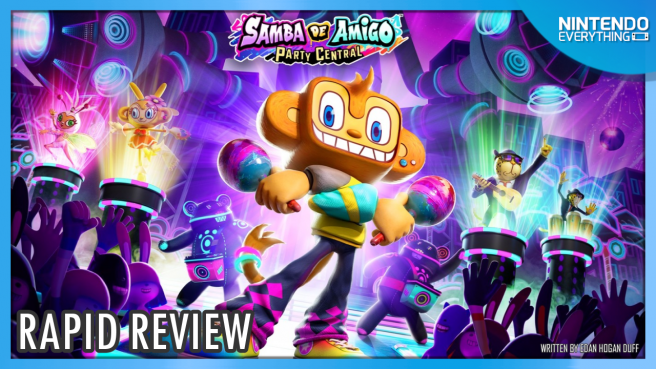System: Switch
Release date: August 29, 2023
Developer: SEGA
Publisher: SEGA
Look, I don’t want to seem ungrateful – but out of all of the franchises SEGA could have thawed from cryo-sleep in 2023, Samba de Amigo was not the one I would have expected. The fan-favorite rhythm action celebration of Latin American music and culture last graced our consoles a whopping 15 years ago, and even that was just a Wii port of an even older title. Nevertheless, SEGA has seen fit to resurrect the franchise with a brand new entry exclusive to Switch, and they’ve even attached series creator Shun Nakamura as the game’s director and producer. You would hope that this pedigree coupled with the the console’s maraca-adjacent control method would result in a pleasantly breezy party-game smash – the reality however, is anything but with Samba de Amigo: Party Central.
On the plus side, the game’s presentation is really great. Each stage you play on across the 40 included tracks bombards your retinas with color, so much so that you’ll come away from your time with Samba de Amigo thinking that SEGA somehow invented brand new colors that we’ve somehow missed out on until now. If you look a little too closely at the game’s onscreen characters you’ll notice some generally awful animation – a little too reminiscent of the Dreamcast in that regard, however the overall aesthetic, execution, and the UI in particular feels polished and lovingly curated to a good standard.
It’s when you look past the pretty visuals and proceed to dig into the core of what Samba de Amigo has to offer that the experience sadly falls apart. The aim of the game is to shake your maracas (not a euphemism) in time with the song being played, and in the direction of six different onscreen zones. Colored orbs float outward from the middle of screen toward these markers, and you shake your Joy-Con in either an upright, horizontal, or downward facing position to score a hit. Design-wise this is great – I’d put Samba up there with Guitar Hero, DDR, and the Hatsune Miku games in terms of its overall format. The execution in this case, however, is terrible. Whether it’s due to the Joy-Con’s inaccurate tracking, latency, or a combination of the two, you don’t really need to concern yourself with how well you match the required poses the game asks for. It feels as though you’re awarded a perfect hit as long as you’re doing literally anything with the Joy-Con. The complete lack of challenge in this regard invalidates a lot of what Samba de Amigo sets out to achieve, and it never manages to make up for these shortcomings.
If you truly do loathe yourself, there is an option to switch off the game’s headline feature – motion controls – and to opt for a convoluted button input control scheme instead. Before I tried this for myself I thought “this must be for people who want to play the game properly” – suffice to say I was wrong. The mapping is unintuitive and the latency between you pressing a button and the hit registering feels completely wide of the mark. There is a suite of options within the game’s settings to account for audio and visual lag – but there’s no way to see the effects of your changes in real time, nor is it especially clear what impact (if any) toggling these options will have on the game. In terms of content, Samba de Amigo makes a decent attempt at adding value in light of its failings. The marquee new addition is the “StreamiGo” mode, which sees you tackling set lists of songs in a faux-streaming environment (complete with fake chatters on the left-hand side of the screen). As you complete each “stream”, you gain followers and unlock cosmetics. It’s a cute idea, but it can’t mask the whiff of cheerlessness the game’s wonky mechanics contribute to the overall package.
Another point of contention can be found in the game’s tracklist – it’s all over the place. The original Samba de Amigo predominantly focused on Latin music with the occasional modern tune spun into the mix. This time, it feels it’s weighted with 40% Latin music from 15 years ago, 50% pop songs that are at least seven years old, and 10% SEGA MP3s. The cultural flavor of Samba de Amigo’s original entry was tightly woven not only into its presentation, but its tracklist too. The franchise’s unique identity has been compromised thanks to a lineup that feels more akin to a Just Dance game from 2015.
The Verdict

Any of the myriad attempts that Samba de Amigo: Party Central makes to build on its shaky foundations are undermined by poor controls and a knowingly forgiving scoring system. No amount of cosmetics, novel single and multiplayer modes, or presentational refinement can mask the fact that this is a wasted opportunity on SEGA’s part. A simplified and responsive control scheme could have made all the difference here – ultimately, however, without significant TLC, Samba de Amigo is destined to shake its way back into annals of rhythm game cult fandom.
Samba de Amigo: Party Central copy provided by the publisher for the purposes of this review.


